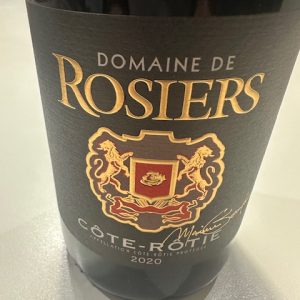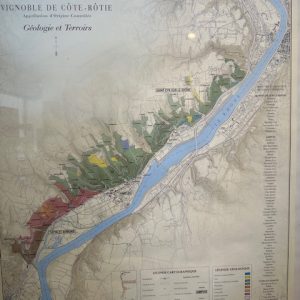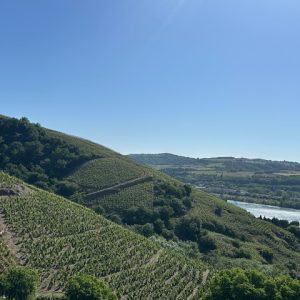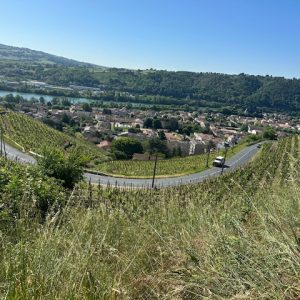Côte-Rôtie
For the naive Anglo-Saxon like me, Côte-Rôtie can be confusing. I took a taxi from Lyon in search of Côte-Rôtie, but there is no such town or village.
Côte-Rôtie is a wine appellation whose grapes are grown near the villages of Ampuis, Saint-Cyr-sur-le-Rhône and Tupin-et-Semons. Ampuis is almost 40 km south of Lyon, but only 8 km south of the old Roman city of Vienne.
The term Côte-Rôtie (“the roasted slope”) is meaningful. Its vineyards lie on steep hill slopes, on the western bank of the Rhone river. Facing the rising sun, they capture lots of heat and are key to the big, rich and intense flavour of Côte-Rôtie.
My taxi dropped me up on top of the vineyards, and I wandered down through the vineyards, overlooking the Rhone. These vineyards are some of the steepest slopes in Europe with inclinations up to 60 degrees, facing south and southeast for optimal ripening.
I arrived in the village of Ampuis, which is not particularly attractive. I only saw Saint-Cyr-sur-le-Rhône from a distance. But it looks beautiful, though small.
For Australians like me, Côte-Rôtie is a must to discover. It is made principally from the Syrah grape variety (known as Shiraz in Australia). Thus, it can resemble the great old Australian reds, which are usually made from Shiraz.
Côte-Rôtie often has a small dose of the white grape Viognier added in. Viognier can bring finesse and femininity to the wine, even if that is politically incorrect. Viognier is the grape of the Condrieu appellation, a neighbour of Côte-Rôtie.
The Côte-Rôtie is one of the few wine appellations that allow white wine grapes to be used in a blend of red wine. The southern Rhône region Châteauneuf-du-Pape AOC is another.
Côte-Rôtie wine lends itself to ageing. It fully develops after 15 years of ageing. It is then characterised by velvety tannins, richness and roundness on the palate as well as a certain aromatic power.
After tasting a couple of wines, I cracked and bought a bottle of Domaine de Rosiers 2020. A spectacular wine from centenaire vines.
Most of my friends don’t understand wine walking. But for me, history and culture come alive as I stroll through these vineyards. And most European vineyards are spectacularly beautiful.
I also enjoy chatting with the folks working in the vineyards. Yesterday, I met a group pruning the vines. One advantage of being an old man, as I am now, is that no-one sees me as a dangerous threat.
When you speak of wine in France, you usually come back to ancient Rome. Indeed, wine has been produced in Côte-Rôtie for 2,400 years! Its terraces were created by the Gallo-Romans to grow vines on the slopes, and harvesting techniques have hardly changed since.
Côte-Rôtie is subdivided into two main sections of varying soil compositions – the Côte Brune (“brown slope”) in the north on dark, iron-rich schist and the Côte Blonde with its pale granite and schist soil.





